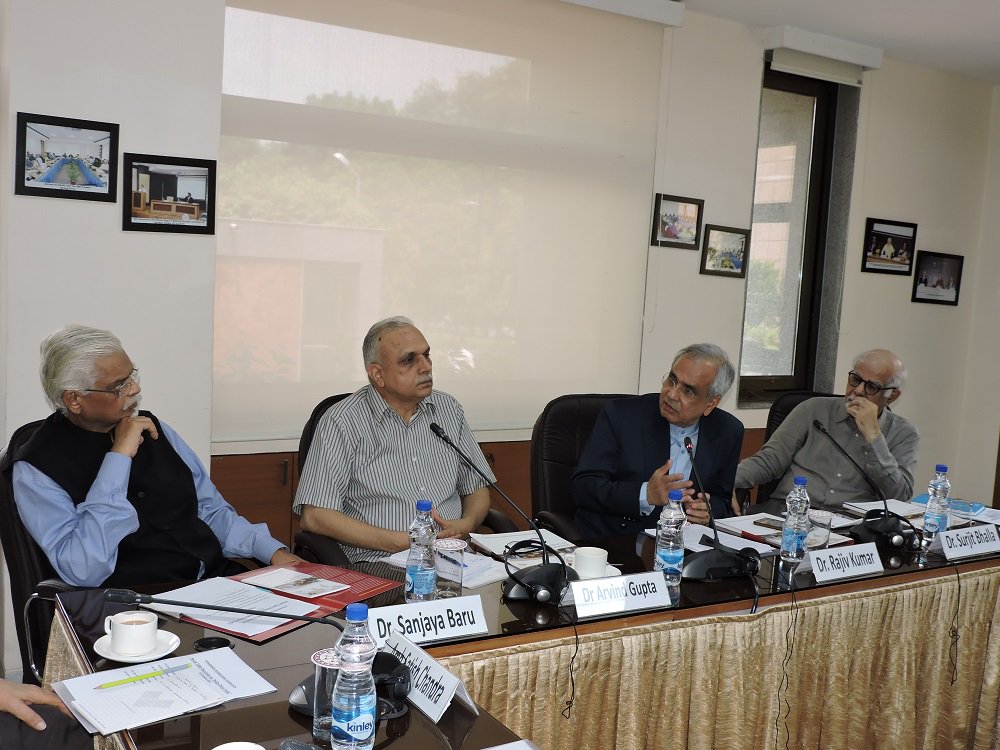The Vivekananda International Foundation (VIF) organised a round table discussion on ‘India-China Trade’, the discussion being presided over by Dr Arvind Gupta, Director, VIF. Dr Rajiv Kumar, Vice Chairman, National Institution for Transforming India (NITI) Ayog, Dr Surjit Bhalla, Member, PM's Economic Advisory Council and Dr Sanjaya Baru, author and economist, made the initial presentations. This was followed by a discussion on India-China trade. The discussion focused on understanding the adverse balance of trade, what it means for India and how to address it.
Until now, four such meetings of the SED have been held in September 2011, November 2012, March 2014 and December 2016. Besides the SED, NITI Aayog has a dialogue with the Development Research Center of the State Council (DRC). On 3 December 2017, the 3rd edition of the DRC-NITI Aayog Dialogue was held in Beijing. The meeting was co-chaired by Dr Rajiv Kumar, and Mr Li Wei, President (Minister), DRC. The dialogue attempts to understand each other’s economy and the related global impact.

The discussion in the fifth Strategic Economic Dialogue (SED) was held at Beijing on April 14, 2018; the next round is scheduled in October. The Indian representatives at the fifth SED were led by Dr Rajiv Kumar, and the Chinese side was led by He Lifeng, Chairman of Development and Reform Commission of China (NDRC). The current status of the understanding reached at the fifth SED between the two sides is as follows:-
- Our ‘red lines’ with the Chinese have been clearly defined. Once the red lines were defined it became easier for both the sides to move forward. Notably, China was forthcoming in accepting the red lines. It was evident that there was a lot of scope for India-China trade.
- It was also clear that China ddi not want to mix economic and strategic issues in the bilateral relations.
- China agreed to address the issue of Non-Tariff Barriers.
- The Chinese side has indicated that it wants to collaborate with India on research and development because they think that India is a major data generator.
- China has suggested that instead of reaching out to the provinces of China, the Indian government should try to do business with the cities of China.
The participants elucidated on the US-China trade sanctions. If bilateral trade gaps are exceptional between countries, trade conflicts/disputes tend to occur. China has an imbalanced bilateral trade gap with the US; hence the trade dispute between the two countries. Thus, while dealing with the India-China trade deficit, India should not look at the bilateral trade gap alone but look at ways to raise exports in general and strategies to reach into the Chinese market.

Recently, the Industrial and Commercial Bank of China (ICBC), has launched China's first India-dedicated public offered investment fund, urging the Chinese to invest heavily since according to it, the Indian economy is entering the "golden age of economic take-off". It was argued that there is an urgent need to make Indian industries more competent and productive. Efforts should be made to understand what determines competitiveness and address it. What is essential is to make Indian Industry achieve global scale in terms of size and reach.
The participants illustrated that trade policy was akin to security policy of any country. Trade has been the essence of national security and national development. The US has realised it, so has China. The participants agreed that India and China are both looking at the changed world and a changing world. On the issue of the industrial model, the participants stated that unlike the Indian industries, the Chinese industries are based on scale. Thus in order to match with China, India needs to upgrade its industries. Additionally, India should look for partners such as Japan, Korea, Taiwan and Germany who can facilitate the industrial growth of the country. The India-US strategic dialogue is also a critical opportunity for India. Once India can increase its industrial capacity and economies of scales are achieved then only India can bridge the trade gap with China.
The points of discussion were as follows:-
- Exhaustive discussions were held on the Regional Comprehensive Economic Partnership (RCEP). It was agreed that while the ASEAN countries want India to stay in the organization, the possibility of India joining the Trans-Pacific Partnership (TPP) should be seriously explored.
- The participants highlighted that there is a need to reform the Indian tax structures, land and labour laws. The principle for taxation should simply be maximisation of revenue, and not uncompetitive high tax regime.
- India has made huge progress in reducing the poverty level in the country. Although the full potential of economic growth to further reduce poverty and raise incomes is yet to be realised. The positive narrative of the growth to trajectory needs to be highlighted. There is a need to change the narrative in India from attending to ‘poverty’ to that of ‘prosperity’.
- The participants mentioned that the Chinese are rattled by the ongoing US-China trade dispute. Consequently, they are suggesting India-China cooperation at various level. India should cooperate with China where it is possible and is in its interest.
To sum up, two points of views emerged from the discussion; a certain section believed that it was an opportune time to cooperate with China while the other believed India needed to be cautious against China’s trade and investments policies. It is imperative for India to think what determines competitiveness and take necessary steps to be globally competitive.






Post new comment